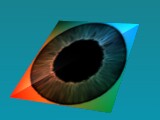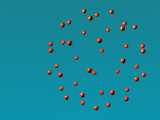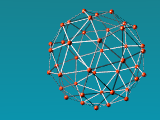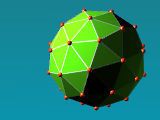|
Jean-Michel Soler, fevrier/mars/avril
2002 .
| Structure
des fichiers /1 :Page précedente |
|
Structure
des fichiers 2/n
Objet
Povray 3.5 Mesh2
|
Objectif
Syntaxe
Textures
multiples
Textures
UV mappées
Taille
des fichiers
Faces
adoucies
Mélanges:
textures
et faces adoucies...
Modificateurs :
inside
vector |
Goal
Syntaxes
multiples
textures
UV
mapped textures
Size
of the files
Softened
Faces
Mixtures:
textures
and softened faces ...
Modifyings :
inside_vector |
| Le mesh2
est un objet récent dans la boite à outil de povray. Il n'existe
que dans la toute dernière version en date, la 3.5 (mais son utilisation
a été banalisée par les versions de Megapov,
fer de lance des nouvelles technologies de Povray)
Objectif:
Permettre l'utilisation
d'un très grand nombre de triangles en se basant sur une définition
plus proche de la géométrie des objets produits par
les modeleurs les plus courants
qui sont généralement de type "surfacique"
... |
The mesh2 is a recent object among the tool box
of povray. It only exist in the very last version, the 3.5 (but its utilization
is very commonplace now due to Megapov, the spearhead of the new Povray
technologies).
Goal:
Allowing the use of a great number of triangles based on an object
definition closer to the geometry as used in most of the modellers
and that generally produces objects of the type "surfaced"
...
|
|
|
| ...alors que povray manipule
des objets de manière "volumique". |
...when povray uses objects in a " volumic"
manner. |
 |
 |
|
Blender
|
Povray
|
|
| A gauche, un mesh réalisé
dans Blender. A droite, le même mesh exporté au format mesh2
à l'aide d'un script python, Povanim, et rendu au travers
de povray 3.5 |
On the left, a mesh realised in Blender. On the
right, the same mesh exported in mesh2 format with the help of a python
script, named Povanim and rendered through povray 3.5.
|
| Syntaxe: |
Syntaxes:. |
mesh2 {
// Vecteurs:
vertex_vectors
{
nombre_de_sommets,
<sommet1>, <sommet2>, ...
}
normal_vectors
{
nombre_de_normales,
<normale1>, <normale2>, ...
}
uv_vectors
{
nombre_de_vecteurs_uv,
<vect_uv1>, <vect_uv2>, ...
}
// Listes:
texture_list
{
nombre_de_textures,
texture { Texture1 },
texture { Texture2 }, ...
}
// Indices:
face_indices
{
nombre_de_faces,
<sommet_index_a, sommet_index_b, sommet_index_c> [,texture_index [,
texture_index, texture_index]],
<sommet_index_a, sommet_index_b, _sommet_index_c> [,texture_index [,
texture_index, texture_index]],
...
}
normal_indices
{
nombre_de_faces,
<index_a, index_b, index_c>,
<index_d, index_e, index_f>,
...
}
uv_indices
{
nombre_de_faces,
<index_a, index_b, index_c>,
<index_d, index_e, index_f>,
...
}
// Modificateurs de Mesh :
inside_vector <direction>
(..modificateurs d'objets..)
(..transformations..)
}
|
|
| La syntaxe peut paraître
très compliquée mais la définition minimale d'un mesh2
peut se limiter à cela: |
The syntaxes may appear very complicated but the
mesh2 minimum definition can be reduced to this:
|
mesh2 {
// Vecteurs:
vertex_vectors
{
nombre_de_sommets,
<sommet1>,
<sommet2>, ...
}
// Indices:
face_indices
{
nombre_de_faces,
<sommet_index_a,
sommet_index_b, sommet_index_c> [,texture_index [,
texture_index, texture_index]],
<sommet_index_a,
sommet_index_b, _sommet_index_c> [,texture_index [,
texture_index, texture_index]],
...
}
} |
|
| Voici un exemple très
simple de mesh2 (celui qui illustre le haut de cette page): |
Here is a very simple example of mesh2 (the
one that illustrates the top of this page):
|
//povray version 3.5
sky_sphere{
pigment{ gradient z
color_map{
[0.0 color rgb<0.14,0.45,0.47>][0.50 color rgb<0.0,0.64,0.77>]
[1.0 color rgb<0.14,0.45,0.46>]
} } scale 2 rotate x*45 }
#declare Material_001_pig=pigment{color rgb <0.0,1.0,0.41> }
#declare Material_001_fsh=finish {
ambient 0.1 diffuse 0.6 specular 0.325 roughness
0.029 }
#declare Plane2 = mesh2 {
vertex_vectors{
4,
<3.8,16.9,0.45>,<4.07,4.4,-2.23>,
<-8.7,1.48,-1.49>,<-7.3,15.55,-4.02>
}
face_indices{
2,
<0,2,1>,<0,3,2>
}
}
object{ Plane2
scale<1.27,1.27,1.27> rotate<65.85,20.24,-2.42>
translate<4.16,-1.77,-12.80>
pigment{Material_001_pig} finish{Material_001_fsh}
}
camera {
location <0, 0, 0> look_at <0, 0, 1>
right <-1.33333333333, 0, 0>
up <0, 1, 0> angle 27.912
rotate <0, 180, 0> scale <1.0, 1.0, 1.0>
rotate <90, 0.0, 0.0> translate <5.42, -50.4,
-2.2>
}
#declare Lamp_001 = light_source{
0*x color rgb<1.0, 1.0, 1.0>
spotlight point_at <0,0,-1> radius 12.95
tightness 0.42
falloff 22.5
area_light<8, 0, 0> <0, 0, 8> 4, 4
adaptive 0 jitter circular orient
fade_distance 110.0 fade_power 1
}
object{ Lamp_001
rotate <59, -25.68, -35.81> translate <-17.02,
-15.51, 14.34>
} |
|
Textures
multiples et texture_list :
Certains logiciels de 3D,
offrent la possibilité de "peindre" les couleurs sur chaque sommet
d'un triangle. La définition d'une texture_list permet de reproduire
cet effet en offrant la possibilité d'associer une texture différente
à chaque sommet d'une face . |
Multiples
textures and texture_list :
Some 3D software offers the ability to paint colours on each vertex
of a triangle. The definition of a texture_list allows reproducing this
effect offering the ability to join a texture to each vertex of a face. |
 |
 |
|
Blender
|
Povray
|
|
| Le mesh de gauche est modelé
et colorié dans Blender. Dans ce cas particulier, la lumière
a été augmentée pour faire ressortir les couleurs.
Celui de droite est rendu dans povray. Un tel objet devrait être
déclaré de la manière suivante: |
The mesh on the left is modelled and painted in
Blender. In this particular case, the light has been increased to improve
the visibility of the colours. The one on the right is rendered in povray.
Such an object should be declared the following manner:
|
#declare Plane2 = mesh2 {
vertex_vectors{4, <3.8058,16.9311,0.4496>,
<4.0735,4.3990,-2.2274>,
<-8.6940,1.4797,-1.4879>,
<-7.2997,15.5429,-4.0221>
}
texture_list{ 4,
texture{pigment{rgb<0.0,0.44,0.66>}finish{Material_001_fsh}}
texture{pigment{rgb<0.87,0.19,0.0>*1.0}finish{Material_001_fsh}}
texture{pigment{rgb<0.01,0.39,0.16>*1.0}finish{Material_001_fsh}}
texture{pigment{rgb<0.0,0.13,0.054>*1.0}finish{Material_001_fsh}}
}
face_indices{2, <0,2,1>,0,1,2,
<0,3,2>,0,3,1 }
} |
|
Textures
UV mappées :
La grande
force des logiciels surfaciques est la possibilité d'ajouter des
images repérées par des coordonnées uv . Ces informations
sont gérées par un tableau de vecteurs nommé uv_vectors.
Chacun de ces vecteurs est associé à un sommet de face.
Noter bien qu'un sommet de la liste vertex_vectors peut être
utilisé par un nombre indéterminé de faces et que
chaque face uvmappée aura automatiquement trois uv_vectors associés. |
UV
mapped textures:
The great strength of surfaced software is the ability to add pictures
located with uv coordinates. These information are handled through a vectors
table named uv_vectors. Each of the vectors is linked to a face's vertex.
Take notice of that, the vertex of the list vertex_vectors can be
used by a undetermined number of faces and that each uvmapped face will
have automatically three uv_vectors associated. |
 |
 |
|
Blender
|
Povray
|
|
| L'exemple ci-dessus sera déclaré
de la manière suivante: |
The example here above will be declared the following
way :
|
#declare Plane2 = mesh2 {
vertex_vectors{ 4,
<3.8058,16.9311,0.4496>,<4.07356,4.3990,-2.2274>,
<-8.694,1.4797,-1.4879>,<-7.2997,15.5429,-4.0221>
}
uv_vectors{ 6,
<0.98907,0.98907>,<0.00546,0.00546>,<1.0,0.01093>,
<0.98907,0.98907>,<0.00546,1.0>,<0.00546,0.00546>
}
texture_list{ 4,
texture{pigment{average
pigment_map{
[1.0 color rgb<0.0,0.44,0.66>][1.0 img0]}}
finish{Material_001_fsh}}
texture{pigment{average
pigment_map{
[1.0 color rgb<0.875,0.19,0.0>][1.0img0]}}
finish{Material_001_fsh}}
texture{pigment{average
pigment_map{
[1.0 color rgb<0.011,0.39,0.16>][1.0 img0]}}
finish{Material_001_fsh}}
texture{pigment{average
pigment_map{ [1.0 color rgb<0.0,0.13,0.054>][1.0 img0]}}
finish{Material_001_fsh}}
}
face_indices{ 2,
<0,2,1>,0,1,2, <0,3,2>,0,3,1
}
uv_indices{ 2,
<0,1,2>,<0,1,2>+3
}
uv_mapping
} |
|
Taille
des fichiers :
Une
simple sphère peut comporter 42 sommets et 80 faces. |
Size
of the files :
A simple sphere can contain 42 vertices and 80 faces. |
.
 |
 |
 |
|
Sommet/Vertex
|
Cotés/Edges |
Facette/Face |
|
 |
 |
|
Blender
|
Povray
|
|
| Le modèle qui est présenté
ci-dessus (à gauche le mesh Blender, à droite le mesh2 rendu
par povray) devient un texte particulièrement indigeste comme on
peut le voir dans les lignes qui suivent. |
The model shown here above (on the left the Blender
mesh, on the right the mesh2 rendered by povray) becomes a particularly
indigestible text as you can see by reading the following lines..
|
#declare Sphereexport2 = mesh2
{
vertex_vectors{ 42,
<6e-008,0.0,-3.979780674>,
<2.879769325,-2.092250109,-1.779817104>, <-1.099951625,-3.385360479,-1.779817104>,
<-3.559614897,0.0,-1.779817581>,<-1.099951625,3.385360718,-1.779817581>,
<2.879769325,2.092250347,-1.779817581>,<1.099951744,-3.385360479,1.779817581>,
<-2.879769325,-2.092250109,1.779817581>,<-2.879769325,2.092250347,1.779817343>,
<1.099951744,3.385360718,1.779817343>,<3.559614897,0.0,1.779817581>,
<6e-008,0.0,3.979780436>,<1.692691207,-1.22979784,-3.385416508>,
<-0.646537423,-1.98987174,-3.385417461>,<1.04616034,-3.219688654,-2.092320442>,
<1.692691207,1.229797363,-3.385416508>,<3.385391712,0.0,-2.09231329>,
<-2.092288971,0.0,-3.385406971>,<-2.738842487,-1.989877939,-2.09231472>,
<-0.646537423,1.989871502,-3.385417461>,<-2.738842487,1.989877701,-2.09231472>,
<1.04616034,3.219688416,-2.092320442>,<3.785001755,1.229802608,0.0>,
<3.785001755,-1.229802608,0.0>,<2.339257956,-3.21970892,0.0>,
<6e-008,-3.979780674,0.0>,<-2.339257717,-3.21970892,0.0>,
<-3.785001755,-1.229802608,0.0>,<-3.785001755,1.229802608,0.0>,
<-2.339257717,3.219708443,0.0>,<6e-008,3.979780197,0.0>,
<2.339257956,3.219708443,0.0>,<2.738842726,-1.989877701,2.092314959>,
<-1.046160221,-3.219688654,2.092320681>,<-3.385391712,0.0,2.09231329>,
<-1.046160221,3.219688416,2.092320204>,<2.738842726,1.989878178,2.092314482>,
<2.092288971,0.0,3.385406733>,<0.646537542,-1.989871264,3.385417461>,
<-1.692691088,-1.229797363,3.385416985>,<-1.692691088,1.22979784,3.385416985>,
<0.646537542,1.989871502,3.385417461>
}
face_indices{80,
<12,14,13>,<12,15,16>,<13,18,17>,<17,20,19>,<19,21,15>,
<16,22,23>,<14,24,25>,<18,26,27>,<20,28,29>,<21,30,31>,
<23,32,24>,<25,33,26>,<27,34,28>,<29,35,30>,<31,36,22>,
<32,37,38>,<33,38,39>,<34,39,40>,<35,40,41>,<36,41,37>,
<9,41,36>,<11,37,41>,<10,36,37>,<8,40,35>,<11,41,40>,
<9,35,41>,<7,39,34>,<11,40,39>,<8,34,40>,<6,38,33>,
<11,39,38>,<7,33,39>,<10,37,32>,<11,38,37>,<6,32,38>,
<5,31,22>,<10,22,36>,<9,36,31>,<4,29,30>,<9,30,35>,
<8,35,29>,<3,27,28>,<8,28,34>,<7,34,27>,<2,25,26>,
<7,26,33>,<6,33,25>,<1,23,24>,<6,24,32>,<10,32,23>,
<4,30,21>,<9,31,30>,<5,21,31>,<3,28,20>,<8,29,28>,
<4,20,29>,<2,26,18>,<7,27,26>,<3,18,27>,<1,24,14>,
<6,25,24>,<2,14,25>,<5,22,16>,<10,23,22>,<1,16,23>,
<0,19,15>,<5,15,21>,<4,21,19>,<0,17,19>,<4,19,20>,
<3,20,17>,<0,13,17>,<3,17,18>,<2,18,13>,<0,15,12>,
<5,16,15>,<1,12,16>,<0,12,13>,<2,13,14>,<1,14,12>
} |
|
| Si l'on fait appel à
des opérations de subdivision pour adoucir la forme, on va multiplier
de manière exponentielle les informations rébarbatives. Si
l'on prend en considération que des objets de moyenne résolution
peuvent atteindre plusieurs dizaines de milliers de faces, la gestion de
toutes les informations groupées d'un mesh2 devient proprement impossible
dans un traitement de texte classique. Heureusement il est possible de
réaliser des #include |
If we use dividing operations to soften the shape,
we are going to dramatically increase the number of points composing the
object and thus, heavy and repugnant information. Even if weonly consider
objects of middle resolution, they contain tens of thousand faces. Handling
with such an amount of data becomes queeckly impossible in a basic word
processor. Luckily we can use #include.
|
..
 |
 |
|
Blender
|
Povray
|
|
| Alors que l'objet ci-dessus
contient 4 fois plus de faces que le précedent, sa gestion se limite
maintenant à deux simples lignes. |
However the here above object contains 4 times more
faces than the preceding one, you can see that it takes only two lines
in the file.
|
.
#declare Sphereexport2 = mesh2
{
vertex_vectors{ #include "Sphereexport2verts.inc"}
face_indices{ #include "Sphereexport2faces.inc"}
} |
|
| Face
adoucies: |
Softened
faces : |
 |
 |
|
Blender
|
Povray
|
|
| Les vecteurs normaux permettent de donner un aspect plus lissé
à la forme de manière plus économique que la subdivision
des facette. |
The normals vectors allow giving a smother aspect
to the shape in a more economic way than the subdivision of the faces.
|
|
| Si certaines faces restent à l'état brut, il faut ajouter
la déclaration: |
If certain faces stay at the raw state, you have
to add the declaration:
|
. |
| Exemple: |
Example: |
#declare Sphereexport2 = mesh2 {
vertex_vectors{ #include "Sphereexport2verts.inc"}
normal_vectors{ #include "Sphereexport2norm.inc"}
face_indices{ #include "Sphereexport2faces.inc"}
normal_indices{ #include "Sphereexport2nindice.inc"}
} |
. |
| Mélanges:
listes de textures et faces adoucies... |
Mixtures:
textures list and softened faces ... |
 |
 |
|
Blender
|
Povray
|
|
| Exemple: |
. |
#declare Sphereexport2 = mesh2 {
vertex_vectors{ #include "Sphereexport2verts.inc"}
normal_vectors{ #include "Sphereexport2norm.inc"}
texture_list{ #include "Sphereexport2text_list.inc"}
face_indices{ #include "Sphereexport2faces.inc"}
normal_indices{ #include "Sphereexport2nindice.inc"}
} |
|
| ...
plus texture uvmappées: |
...
plus uvmapped textures: |
 |
 |
|
Blender
|
Povray
|
|
| Exemple: |
Example:. |
#declare Sphereexport2 = mesh2 {
vertex_vectors{ #include "Sphereexport2verts.inc"}
uv_vectors{ #include "Sphereexport2uvco.inc"}
normal_vectors{ #include "Sphereexport2norm.inc"}
texture_list{ #include "Sphereexport2text_list.inc"}
face_indices{ #include "Sphereexport2faces.inc"}
normal_indices{ #include "Sphereexport2nindice.inc"}
uv_indices{ #include "Sphereexport2uvind.inc"}
uv_mapping
} |
|
| ...
Modificateurs : inside_vector: |
...
Modifying : inside_vector: |
|
|
| CSG, union et difference
ou intersection: |
CSG, union and substraction
or intersection: |
| Exemple: |
Example:. |
|
|
|
| . |
. |
|
|
 Tous les droits réservés
pour le logo "povanim", les explications, scripts et images sur ces pages
par JM Soler fevrier/juin 2002.
Tous les droits réservés
pour le logo "povanim", les explications, scripts et images sur ces pages
par JM Soler fevrier/juin 2002.
Pour toutes les questions touchant
les éventuels problèmes rencontrés avec cette page
contacter l'auteur sur le forum de discussion:
3D.Blender
|
| Structure
des fichiers /1 :Page précedente |
|
|
Index
principal
|
|

